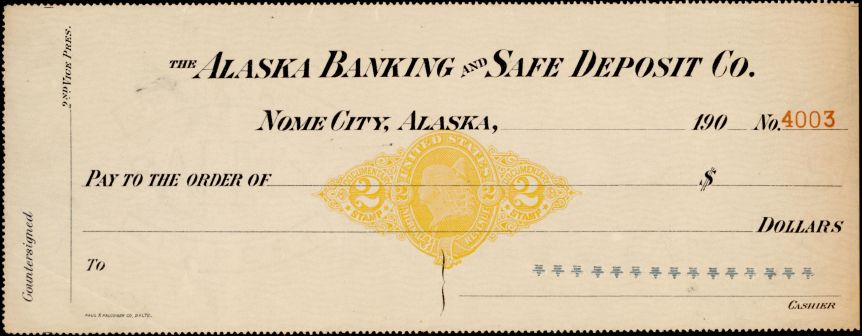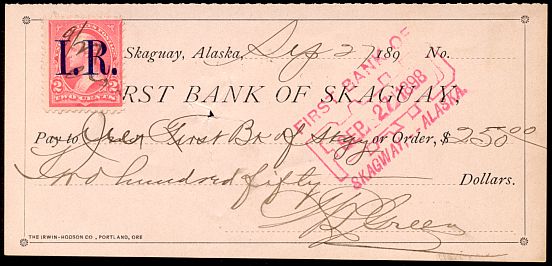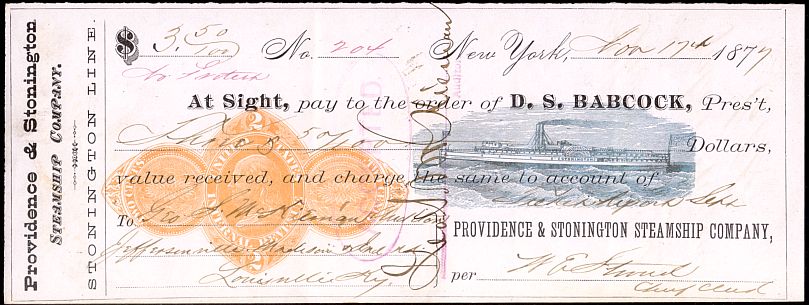by Bill Castenholz and Bob Hohertz
The illustrated item is a great rarity – a check from an Alaskan bank intended for use during the period from 1900 through mid-1901, as evidenced by the imprinted revenue.

The Alaska Banking and Safety Deposit Company was the scene of high drama in 1900. That was when the crafty politician Alexander McKenzie began his moves to take over the Discovery gold claim by advancing the case of a claim-jumper before judges who were his allies. While lawyers for the original owners were taking their case to the Circuit Court of Appeals in San Francisco, McKenzie and his group were storing gold in the vaults of this bank. The Circuit Court ruled against McKenzie, but the friendly judge back in Alaska declared that the appeal was improper and the court had no right to hear it.
McKenzie’s opponents were worried that he would remove gold from the Alaska Banking and Safety Deposit vaults, so they took a room across the street from the bank in order to watch it. At one point they stopped him at gun-point and made him return a quantity of gold to the bank.
The situation, which festered into 1901 without actually causing serious violence, encouraged other prospectors to avoid reporting any finds for fear of having them end up being confiscated like the Discovery mines.
The court in San Francisco did not take the matter lightly. In October of 1901 it sent federal marshals to Nome to arrest McKenzie. He was brought to California and sentenced to a year in prison, but President McKinley pardoned him before he served half of it. McKenzie did not return to Nome. He regained power in his native state of North Dakota and to some extent nationally. The judges he left behind in Alaska also returned to California and mild punishment, reputedly in fear of lynching if they had stayed in Nome.
Gold production at Nome reached its height in 1906, but by seven or eight years later it had all been mined and the city shrank from about 25,000 people to about one-fifth that size.
For those who are collectors of revenue stamped checks, it is exciting to know that these were used in Alaska. Where there is one, there might be more….
The original article ran in the July – September 1995 issue of The Check Collector.
Postscript…
Not another imprinted check, but this ran in the April – June 1999 Check Collector.
A Find on the Internet

The illustrated check was obtained recently through an internet auction. Revenue stamped paper checks from Alaska are quite rare – one with a printed Alaska dateline known to date – and checks bearing adhesive revenues from there are not at all common. This one was used in Skagway, then spelled Skaguay, on September 27, 1898, fairly early in the Spanish American War check tax period. The town itself was in the midst of a series of changes bringing it from a wild frontier town to a more respectable settlement.
Skagway was founded in 1897. The first wave of gold rush stampeders arrived in July, and in October Soapy Smith and five henchmen made their appearance, fleeing the results of various criminal activities in Colorado. These hoodlums virtually ran the city for several months, until a number of citizens formed a group to get rid of them. On July 8, 1898, a series of events led Smith to try to break up a meeting of the vigilantes, which resulted in his being fatally shot. His friends were ordered out of town, and US Army troops were called in to prevent lynchings.
By the time this check was written, a bit over two months later, the town was struggling with financing public schools and fire-fighting equipment through a series of taxes on merchants and donations by private individuals.
More interesting detail on this period can be found in The Alaskans, published in 1977 as a part of the Time-Life Series The Old West.
